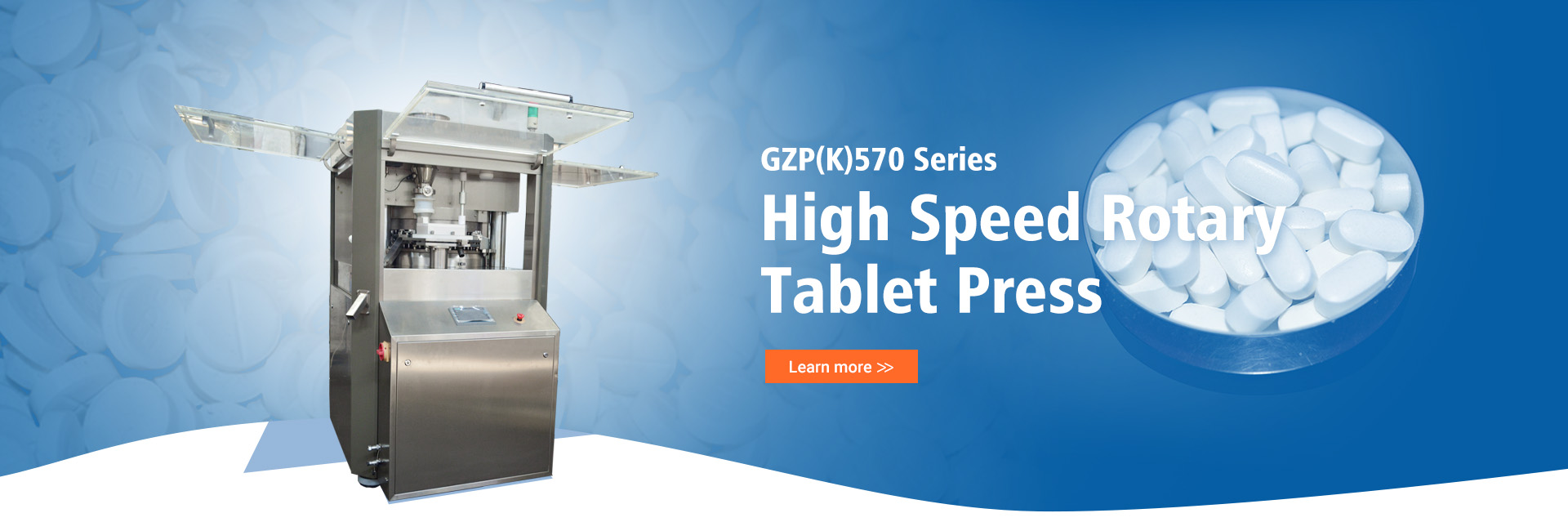Tablet presses are mainly used for tablet process research in the pharmaceutical industry. The tablet press is an automatic continuous production equipment for compressing the granules into round, special-shaped and sheet-like objects with characters, symbols and graphics with a diameter of not more than 13mm. For some pharmaceutical tablet presses, when burrs and dust appear during tablet compression, the sieve machine should be equipped with dust removal at the same time (more than twice), which must meet GMP specifications.
Chinese name: tablet press; English name: tablet press machine definition:
Tablet press definition: According to the nomenclature standard, there are the following definitions for tablet press:
(1)Tablet press, a machine that compresses dry granular or powdery materials into tablets through a die.
(2)Single-punch tablet press, a tablet press with a pair of molds for vertical reciprocating motion.
(3)Rotary tablet press, a tablet press in which multiple pairs of molds evenly distributed on the rotating turntable perform vertical reciprocating motion according to a certain trajectory.
(4)High-speed rotary tablet press, the linear speed of the axis of the mold rotating with the turntable is not lower than 60m/min.
Classification: Models can be divided into single punch tablet press, flower basket tablet press, rotary tablet press, sub-high-speed rotary tablet press, automatic high-speed tablet press and rotary core-spun tablet press.
Structure and composition:
A machine that places granules or powdery materials in a die hole and compresses them into tablets by a punch is called a tablet press.
The earliest tablet press was composed of a pair of punching dies. The punch moved up and down to press granular materials into sheets. This machine was called a single punch tablet press, and later developed into an electric flower basket tablet press. The working principle of these two tablet presses is still based on the unidirectional tablet pressing based on the manual pressing die, that is, the lower punch is fixed during tablet pressing, and only the upper punch moves
to pressurize. In this way of tableting, due to inconsistent upper and lower forces, the density inside the tablet is not uniform, and problems such as cracks are easy to occur.
Aiming at the shortcomings of the unidirectional tablet press, a rotary multi- punch bidirectional tablet press was born. The upper and lower punches of the tablet press uniformly pressurize at the same time, so that the air in the drug particles has sufficient time to escape from the die hole, thereby improving the uniformity of tablet density and reducing the phenomenon of splitting. In addition, the rotary tablet press has the advantages of low machine vibration, low noise, low energy consumption, high efficiency and accurate tablet weight.
Rotary tablet press is a machine that presses granular materials into tablets by pressing multiple dies evenly distributed on the turntable to move up and down in a circle according to a certain trajectory. The tablet press with the linear speed of the punch rotating with the turntable ≥ 60m/min is called a high-speed rotary tablet press. This high-speed rotary tablet press has a forced feeding mechanism. The machine is controlled by PLC, with automatic pressure adjustment, control The functions of sheet weight, rejecting waste sheets, printing data, and displaying fault stoppages, in addition to controlling the difference in sheet weight within a certain range, can automatically identify and eliminate quality problems such as missing corners and loose pieces.
The tablet shape pressed by the tablet press is mostly oblate at first, and later developed into shallow arc and deep arc on the upper and lower sides, which is for the needs of coating. With the development of special-shaped tablet presses, oval, triangular, oval, square, diamond, annular and other tablets are produced. In addition, with the continuous development of preparations, due to the requirements of compound preparations and timed-release preparations, special tablets such as double-layer, triple-layer and core-coated preparations are made, which all need to be completed on a special tablet press.
With the development of market demand, the scope of application of tablet presses is becoming wider and wider. It is no longer simply limited to pressing Chinese and Western medicine tablets, but can also be widely used for pressing health food, veterinary medicine tablets, chemical tablets: such as mothballs Sanitary balls, washing blocks, Smurf blocks, art powder, pesticide tablets, etc.,
food tablets: chicken essence blocks, Banlangen blocks, Divine Comedy tea blocks, compressed biscuits, etc.
The working process of the tablet press
The working process of the tablet press can be divided into the following steps:
1.The punch part of the lower punch (its working position is upward) extends into the middle die hole from the lower end of the middle die hole to seal the bottom of the middle die hole;
2.Use the feeder to fill the middle die hole with medicine;
3.The punch part of the upper punch (its working position is downward) falls into the middle die hole from the upper end of the middle die hole, and goes down for a certain stroke to press the powder into tablets;
4.The upper punch lifts the exit hole. The lower punch rises to push the tablet out of the middle die hole to complete a tableting process;
5.Lower the flush down to its original position, ready for the next fill.
Post time: May-25-2022



